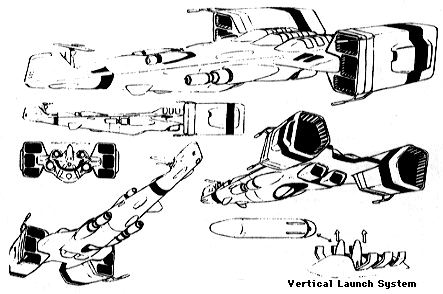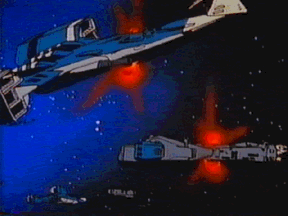

Designation:Oberth-class Armored Missile Escort Ship (AMES), redesignated to Destroyer(DD) in 2013. |

|
||||

|
|||||
| AMES-01 Oberth | Commissioned 2007 | Destroyed by the Koroljev, 2008. |
| DD-02 Goddard | Commissioned 2007 | Decommissioned 2023. |
| AMES-03 Koroljev | Commissioned 2007 | Destroyed by Goddard, 2008. |
| DD-04 Tsjolkovsky | Commissioned 2007 | Destroyed 2014 in Earth orbit. |
| AMES-05 Miranda | Commissioned 2007 | Destroyed 2009 in Earth orbit. |
| DD-06 Desdemona | Commissioned 2008 | Decommissioned 2023. |
| AMES-07 Circe | Commissioned 2008 | Destroyed 2009 in Earth orbit. |
| AMES-08 Titania | Commissioned 2008 | Destroyed in Zentraedi Holocaust. |
| AMES-09 Cordelia | Commissioned 2008 | Destroyed 2009 in Lunar orbit. |
| AMES-10 Esther | Commissioned 2008 | Destroyed 2009 in Earth orbit. |
| DD-11 Dido | Commissioned 2009 | Decommissioned 2023. |
| AMES-12 Katherine | Commissioned 2009 | Destroyed in Zentraedi Holocaust. |
| AMES-13 Beatrice | Commissioned 2009 | Destroyed in Zentraedi Holocaust. |
| DD-14 Deidamia | Commissioned 2009 | Decommissioned 2023. |
| AMES-15 Lavinia | Commissioned 2009 | Destroyed in Zentraedi Holocaust. |
| DD-16 Hermine | Commissioned 2010 | Decommissioned 2023. |
| AMES-17 Galadriel | Commissioned 2010 | Destroyed in Zentraedi Holocaust. |
| AMES-18 Roxanne | Commissioned 2010 | Destroyed in Zentraedi Holocaust. |
| DD-19 Cosette | Commissioned 2010 | Decommissioned 2023. |
| AMES-20 Jane Eyre | Commissioned 2010 | Destroyed in Zentraedi Holocaust. |
These ships were built at the L-5 Factory Station and entered service from 2007 through 2010.

The Oberth-class of System Destroyers was the first Earth design for a space warship, and was during the first years of the 21th century the prime vessel for the further exploration, examination, exploitation and transport of, for and between the planets of the solar system. As the first design and with only partially understood technologies, it had its flaws, but it served faithfully before, during and after the First Robotech War.
Like the Armor-class Space Carriers, the Oberth-class was designed to fight the Zentraedi fleets as they were hypothesized from the wreckage of the SDF-1: one large mothership of the SDF-1 type, and a number of smaller escort ships, which might or might not have fold-capability. As such, the Zentraedi Tou Redir came reasonably close to the escort ships of the military theorists' pipe dreams, but even these smaller ships were far more powerful than had been anticipated, and the Oberth-class, designed to fight these ships, was usually overmatched against even these types.
Deck one contained an observation deck and the Captain's briefing room. Deck two contained the radio and sensor room, navigational computers, and the Captain's space cabin. Deck three was divided into three disconnected sections, all of which were accessible from deck four. In the forward section of deck three the main bridge and fire control was located. The midship region contained accessways to the gun machinery for the topside particle beam cannons. In the aft section of deck three was the service access to the triple ballistic missile launchers. Deck four was the main deck; here were the sick-bay, officers' and crew quarters, and the mess area located. Deck five was the main engineering deck. The main computers, the environmental support systems, the side gun machinery, machine shops, and aft, main engineering were located here. Deck six, which had no gravity, was the shuttle bay and service deck.
The vessel was manned by 24 officers and 76 enlisted personnel. There was often a Marine platoon of 36 men stationed aboard these vessels for landing actions (such as the incident on Mars Base Sera before the Zentraedi arrived) as well as the boarding of derelict craft. Four technical specialists were typically attached to the Marines. In addition, almost 500 personnel could be carried on board for short periods, and this capacity was used for the embarkation of scientists, and for when the vessels were used as transport vessels between the various planets of the solar system.
There were two flights in the production run; the first flight of four ships, named after space pioneers, having four identical forward cannons. The second flight, named after famous women from world literature, had two of its cannons replaced with more powerful versions, and also featured an enlarged hangar.
The Oberth-class was well-armed for its size and design era, with 4 powerful forward fixed particle guns, multiple point-defense lasers, and 18 deadly anti-warship missiles. Nevertheless, it was still easily outmatched by the most comparable Zentraedi vessel, the Tou Redir scout, which was more effectively armed, armored, and faster. An Oberth-class ship can prevail against this smallest and most numerous of Zentraedi vessels only if it utilized its maneuverability to avoid the scout's guns while it tried to bring its forward battery to bear. However, the limited field of fire of the main gun battery made the Oberth's attack run fairly predictable for Zentraedi fire control parties, with usually unpleasant results.
In order to cut down on transit times, expeditions to the outer planets always started with orbital slingshots around the Moon and the Earth, sometimes even around the Sun. This experience of the UN Spacy in slingshot maneuvering would later be of great use in the return voyage of the SDF-1 to Earth. It was the intend of the UN Spacy to mount a fold system on the class as soon as these drives could be safely replicated; however, this never happened.
Designed to patrol Earth's solar system and to escort the far more vulnerable A.R.M.D. carrier platforms, this class entered service in 2007, two years before the launching of the SDF-1. Though most were destroyed by the Zentraedi immediately after they entered Earth orbit and when the SDF-1 attempted to link up with Armor 1 and Armor 2, or later when they were recalled to Earth just before the Zentraedi Holocaust, many survived and continued to patrol the solar system until the remainder were decommissioned just before the SDF-3 departed for Tirol, with the exception of Tsjolkovsky which was lost in 2014 in the destruction of the SDF-2 Odyssey.
This vessel was fairly spacious, and was popular with its crews before the Zentraedi arrived, but proved to be woefully underarmed to deal with the far larger and deadlier Zentraedi vessels. They also served to evacuate the personnel of Mars Base Sara because of the threat made by anti-unificationist terrorists that caused the abandonment of the base. The Koroljev was captured by these terrorists, who used it to destroy the Oberth, which was carrying part of the base's complement and was unprepared to resist; all hands were killed. The Goddard was then dispatched after the Koroljev, which had entered a Lunar orbit and was making propaganda broadcasts aimed at the Earth. Shortly before entering Lunar orbit herself, the Goddard ejected several of her Trident missiles. The ship then proceeded in a high orbit and on a standard attack course towards the Koroljev. This ship's hijackers, fully expecting the Goddard to make a head-on attack (the only attack they thought possible in space) prepared for this. They were thus caught completely of guard when the undetected, previously ejected missiles used their occultation by the moon to ignite their engines, and then made a parabolic orbit with a periapsis at a mere 1500 meters above the moon's surface, coming up behind the Koroljev at high speed and using the moon as radar background. Koroljev's crew never even saw them coming. This case was later hailed by Spacy officers as an excellent example of using the particulars of celestial bodies (in this case, the Moon's lack of an atmosphere which made the very close fly-by possible) in space tactics.
Later on, the Oberth-class vessels served admirably in their patrol role after the destruction of the SDF-1, and were instrumental in rooting out and destroying several Zentraedi destroyers and pickets that had escaped the Zentraedi Holocaust. However, they were only assigned these duties as the hunted vessels were damaged and underpowered already, and because allied Zentraedi vessels were standing by to help them out if necessary.
Return to RDF Naval index
Go to Robotech Reference Guide Home Page
Robotech (R) is the property of Harmony Gold. This document is in no way intended to infringe upon their rights. The authors have received no remuneration for this work.
Content by Pieter Thomassen and Peter Walker
Copyright © 1998, 1997, 1995 Robert Morgenstern, Peter
Walker, Pieter Thomassen
Last Updated: Wednesday, August 12, 1998 7:02 PM